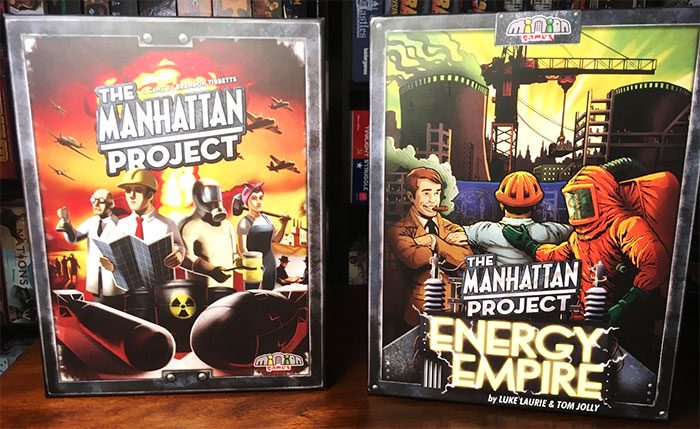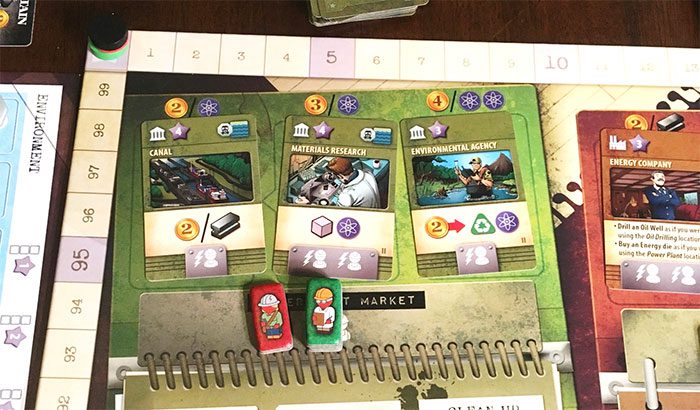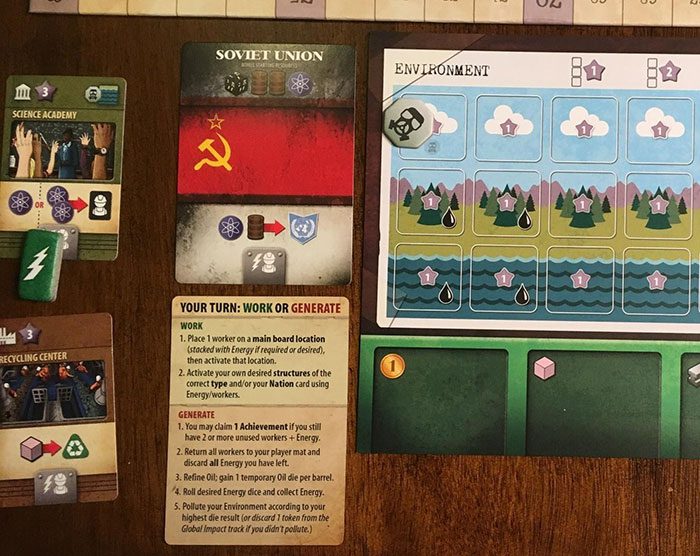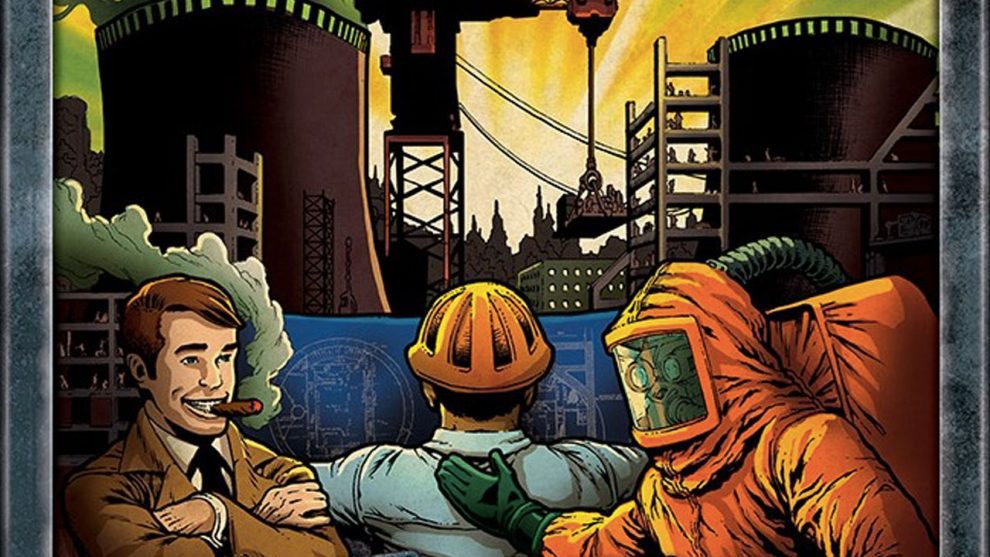Engine building is a popular concept all euro-gamers are familiar with. Engine building appears in heavier games like Agricola and Keyflower, deck/bag-building (where the entire game is debatably engine building) like Dominion and Orleans, lighter games like Fleet, and tableau builders like Race and Roll for the Galaxy. These games are split into two categories: games like Dominion and Fleet where the engine is the game and games like Keyflower, Orleans, and Roll for the Galaxy where repeated plays are needed to learn to build a high-powered engine. The Manhattan Project: Energy Empire sits in the sweet spot between these types of games.
The Manhattan Project: Energy Empire is a worker placement game where players each take control of a country vying to become a world superpower. Players will build structures, construct power plants, and advance influence in the United Nations all while polluting their countries environment. Whether you’re playing as France taking a risk with nuclear power or Iraq using your oil resources to power your empire, there are multiple paths to victory in The Manhattan Project: Energy Empire.
As a note, The Manhattan Project: Energy Empire is a standalone game, it is not an expansion to The Manhattan Project, and it does not require any knowledge of its predecessor. The only carry-over between the games is the artwork and theme.

Gameplay
The game begins with each player getting dealt two nation cards at random which they select one of to be the country they represent. Players start with three “workers” and two pieces of “energy”, the resources specified on each player’s nation card, and a starting achievement. On their turn, players can perform one of two actions: work or generate. Over the course of the game, players will be competing to score the most victory points through taking over the UN, keeping their environment clean, building structures, and several mechanisms.

When players work, they select one of the 13 locations on the game board and perform the action on that location. Similar to other worker placement games, to select an action a player places a worker on the location, but unlike most worker placements games, if there is already a worker on a location, that doesn’t eliminate it from the player’s options. If an action has already been selected one or more times, players can add pieces of energy to use the action.

The 13 locations are divided into three types: four government locations focusing on the science resource, five industry locations focusing on the steel resource, and four commerce locations focusing on the plastic resource. Each type provides a location to purchase “structures” of that type, literally allowing players to build their engine in the game.

These structures cannot be activated directly, but they can instead be activated after a location of that type. For instance, after a player activates the Education location, they can use their remaining energy and/or workers to activate one or more Government structures they have built.

When players generate, they start by returning all of their workers to their pool and their energy to the supply. They then roll the power plant dice that they have purchased or started with and receive energy from the supply based on their die roll. Careful though, die rolls can also force a player to add pollution on their player boards.
Pollution works as the clock for the game. Depending on player count, there is a fixed amount of pollution tiles available and once the tiles run out, the game ends. Pollution tiles are placed on the player boards based on the results of generation, when some structures are purchased, and for some action locations. There are various locations and structures that allow players to clean up pollution in their environments. Six times throughout the game, global impact events are triggered when pollution is placed. These events score part of your environment, cycle some of the structures available, and have an event which affects all players in the game.

Once the final pollution marker has been placed, each player takes one more turn. After that turn is completed, players score points based on the structures they’ve built, the power plant dice they own, their status on the UN track, and their environment. At the end of the game, the player with the most victory points is the winner of the game.
Components
When I first opened the box, I was convinced I accidentally got the Kickstarter exclusives. The components in this game are NICE. The first component which caught my eye were the dice. There are 24 dice of them used for resource production. On each side of the dice is the number of energy you receive for that side, the rank value of the die, and the type of pollution associated with that die. This is a great design feature since it saves referencing back and forth between your player board.

The next component that stood out to me was the worker and energy pieces. These pieces are cardboard and about twice the thickness of standard cardboard components, which makes them easy to stack and differentiate different pile depths.

The third component that made an impression on me was the resource components, particularly the oil, iron, and plastic components. These three types of resources are all plastic or wooden and nicely painted. Minion Games easily could have made these cardboard punch-out’s (which they did for the science resources and money).

The final component that was great was the player boards. Though they were a little flimsy, they had a lot of great information and they had space nicely reserved for all the other components. The boards show what the sides of all of the energy dice are, have a space for workers, energy, achievements, and resources. Also the environment area is nicely laid out and does a good job of showing the scoring.
The other components were all good quality as well. The nation cards were well designed (on the back of them they had game play overview). The game board nicely laid out all of the spaces of the game and I never felt like was running out of space. The global impact cards nicely laid out the necessary information. I don’t see any real complaints to be made with the component quality.
The last thing of note is the graphic design of the game. Manhattan Project: Energy Empire uses similar artwork to its sibling, Manhattan Project. The artwork is very consistent between the different cards, components, and game board and the art definitely drives the theme. The structures are, for the most part, thematically associated with what they do and the symbols on the pollution markers are a fun touch. Overall, the graphic design enhances the quality of the game.
Basic Strategy
At the start of the game you have two goals available to you, an achievement and your nation card which scores UN points. There are six global impact cards each which can score you up to five points. Each nation card has some specialization for scoring points; use this as your initial target. For instance, if you start with France, which requires a science and 2 dollars to advance on the UN track, try and build a government building which produces science, if you’re Canada which requires a science and an iron to advance, build an industry or science building early on. Commerce is of value to everyone since money universally can be used to buy building and can be traded.
Power plant dice are very valuable. They’re each worth two points at the end of the game and they produce energy. When acquiring dice, remember you cannot go over 10 energy at a time, so getting four nuclear dice, where you expect to get 3 energy per die, is not valuable. Also, balancing dice which produce pollution with those that don’t is valuable early. Its very easy to get behind on your environment’s pollution. At the end of the game, everyone will be trying to fix their environment, so take advantage of the cheap cleaning early on especially if you have a government engine. Structures which clean pollution are valuable because they can score a point each time they’re used.
There is no one path to victory!
The Good
Manhattan Project: Energy Empire is the perfect balance of a medium-heavy weight engine builder with a quick to develop strategy. There are good, basic approaches that you’ll enjoy developing but there are also deeper strategies that allow you to chain together systems as you learn the game. The components are amazing, and they aren’t even Kickstarter exclusives. The theme, developing a country in the post World War 2 world, is great. The game also has a solo variant, which I have tried a few times, and is a nice addition to the game if you enjoy a solitaire option.
Admittedly, the engine building is the most fun part of this game for me. Being able to chain actions together is so exciting, and seeing your run fire off is very rewarding. On each and every turn you’ll be able to use your engine to produce a lot of resources and victory points. In games like Agricola and Terraforming Mars, at some player counts, you just see your engine built but it feels like the game ends as you’re about to get going. This is not the case in Manhattan Project: Energy Empire. Also, the nature of the worker placement, which is similar to favorites like Keyflower, where actions are not completely blocked off when a player selects an action. Worker placement games can be stressful, wondering if your opponent is going to take the spot you need and ruin your strategy. Manhattan Project: Energy Empire really takes that stress away and makes the game less punishing. Finally, the two types of action selection units, workers and energy, adds a unique twist to the game.
This is one of the best games from 2016. In a year with heavy games like Terraforming Mars, Great Western Trail, and A Feast for Odin, Manhattan Project: Energy Empire stands out from the crowd on several levels. Manhattan Project: Energy Empire is a deep, but accessible game that allows you to build a fantastic engine; one which is minimally affected by randomness (a common complaint in Terraforming Mars). The engine you’ve built is multiple levels deep, which is a fairly uncommon trait in engine building games. This concept of multi-layer engine building fits well thematically into the development of a nation. Manhattan Project: Energy Empire scratches the worker placement and engine building itch of games like Keyflower, while having more of a solitaire feel similar to games like Roll for the Galaxy. If you’re a fan of those games, I know Manhattan Project: Energy Empire will find a home in your collection.
The Bad
There are a few complaints about Manhattan Project: Energy Empire I have or I have seen from others.
There is almost no player interaction, even compared with other worker placement games. Since you can re-take actions after other players have used them, the player interaction basically goes away. Some of the global impact cards force player interaction, but honestly it’s pretty minimal.
Players who are Analysis Paralysis (AP) prone may have a hard time making some of the decisions since there are multiple levels to the decision, though your mileage may vary on this one.
The dice are a decently large source of randomness in the game but if you play well you can strategize out most of the randomness.
I haven’t encountered this yet, but it seems like in a 3+ player game, players may get crowded into some strategies and that may leave easier paths for other players.
If this sounds good
So if you’ve read this review and it sounds good, there are a few other resources worth looking at. The Manhattan Project: Energy Empire official rules are available on boardgamegeek, there is an official FAQ for the game, and a full walkthrough YouTube video of the rules from the designer.
Enjoy and happy gaming!
What do you think about The Manhattan Project: Energy Empire? Give us your opinions about what you like and/or dislike about the game in the comments below!











